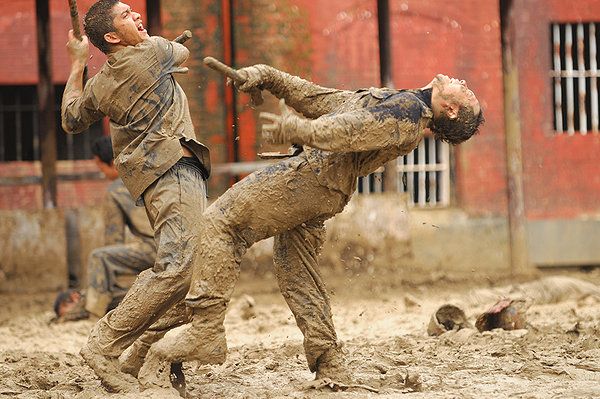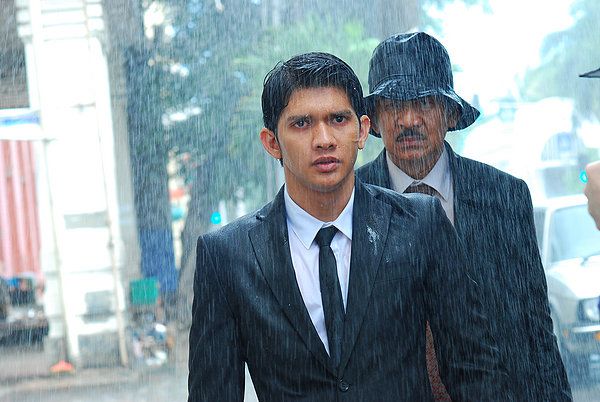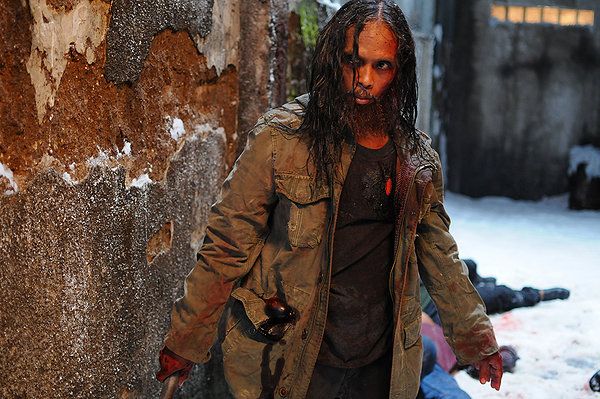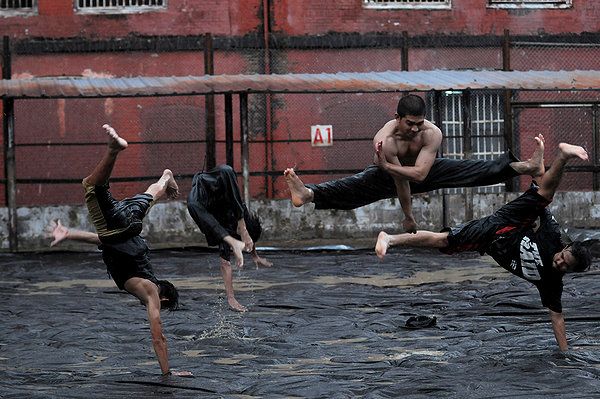If there's a better director of action in the world than Gareth Evans, Hollywood isn't showing us his films. With his breakthrough 2011 film The Raid: Redemption, Welsh-born Evans introduced Indonesia as a hub of ass-kicking action, telling the story of a police officer who must literally fight his way out of a building filled to overflowing with the most vicious, deadly thugs imaginable. Sony Pictures Classics bankrolled a follow-up, The Raid 2, in which the first film's survivor goes undercover to infiltrate the criminal underworld, and Evans makes an even bigger splash the second time around, this time creating a web of intrigue, shifting alliances and breathtaking action that seems unlikely to be surpassed in the U.S., probably as much because of legal limitations as creative ones.
Evans recently sat down with Spinoff Online to discuss the challenges of creating The Raid 2, which unfolds with a machine-like precision that sets up all of the characters and story, and then allows the action to enhance both. In addition to talking about finding new ways to beat people up, he revealed his philosophies about creating and depicting violence, and reflected on the influences and inspirations that led him to build this intricate, riveting adventure.
Spinoff Online: When it comes to creating characters and staging fights, do you know of any instrument or object in the world that has not been used as a weapon in one of these movies at this point?
Gareth Evans: Well for a while I thought I'd seen everything, and then I watched The Yellow Sea. And they used the fucking dog's thighbone. I was like, "Shit, okay, that's one thing down." I really don't know what's left anymore.
How much of that speculation or imagination goes into conceiving the characters or what the fight sequences are going to be like?
Well, to speak specifically about like a character with weapons, like Hammer Girl. Like if that was kind of informed by this desire to do something again with harimau, which is what we used in Merantau, the first film. Harimau was like tiger style, so you're using the palm of your hand to strike and then your fingers to either claw or grab and pull, or drag. And with Hammer Girl, we wanted to find a weapon that was going to be able to allow us to do that harimau style. And then when you look at it, there's only one weapon you can use, it's a claw hammer – use the flat part to hit and then the claw to drag and stab. So it was like, okay, we can use that hammer and we can do that weapon work, but it still feels like it's part of the choreography. Then that allows us to kind of go off in these little flights of fancy then. We can kind of start to create these little creative kills here and there, and it's not an overly aggressive thought process. It's more literally like, well, where would she hit? What would she do? If a guy comes up to her, it was like, okay, well if she stabs him in the arm, it's stuck there. What's she going to do? She can pull him in and then drag his body down and create the momentum and then [hit him] in the face. It's not about, ah, how do I get her to hit this guy in the mouth? How do I get her to smash this guy's skull? It's more about what's the movement, and what's it dictate. Where is the target being dictated by the movement, as opposed to the target dictating the movement. And so sometimes those punch lines, we call them punch lines where it's like a slightly extreme moment, we try to pace them out. So we try to have it so that you have one and you have a break for a couple of people, and then you have another one and break for a couple of people. And the whole reason is to not to just do this overkill thing where it's just punch line, punch line, punch line, because people just get bored of it and they have enough.
What I really like about this movie is that the beginning of the movie feels like it's just being wound super tightly, and then from the moment that he's in prison it's unspooling as aggressively as possible. How tough was it to find the right pacing to present all the information in the beginning so the rest of it could unfold naturally?
Thank you, first of all, because I appreciate you picked up on that – because that first ten minutes was a nightmare to edit. We worked on it and worked on it and worked on it. Me and Aram [Tertzakian], one of my producers, we'd start working on that first reel and that toilet fight would always kick in at about 17 minutes into the film. We were like, this needs to come earlier, and we were trying to figure out what we could cut or what we could trim down, and I started playing around with editing styles, with chronology a little bit. In the John Boorman movie Point Blank, which I love, the whole idea is you have one sound source and the visual, and you can jump out of that to another world but you keep the sound source from the previous shot. And you create this hypnotic effect in a way where you start to get information about these characters, about their backstory about what's happened in the past – and try to fill in all those gaps to end The Raid 1 and start The Raid 2. So for me, it was like the moment we were in prison with him, that's where The Raid 2 really starts. So a large part of that came from borrowing heavily from the editing style of the '70s and '60s movies. So that was a big influence. That was a massive kind of help for me.
What did you feel like had the steepest learning curve on this movie?
The car chase, without a doubt. Because I'd never done that before and it was a new thing for us. It was like a hard thing to begin, just to break down the concept of it and figure out, well, okay, what do we want to do and then how are we going to do it? What shots do we need? What's the rigging for each shot? Because like if I'm doing like a fight scene with Iko [Uwais] or anyone else, I just need my camera on a fig rig, so I can shoot high and shoot low. But car chase stuff was totally different. The car chase was like, all right, I need to get a shot of this guy as he's driving his car. We're going to tow him so we can put the cameras in the box and I could point it at his face. Okay, now let's get another one. We'll just do it from the side of the car. Yeah, that's like another 30-40 minutes because we have to pull down the rigging, take off the tow bar, put the rigging on the side of the car, set it all up and then we do the shot. And it's just like, oh, God, why does it take so long? And then also we'd lose a lot of time as well, not just because of our own fault of not knowing the ins and outs of everything, but also we would book these locations, book these roads and pay the police to be able to use them. And then all of a sudden we arrive on set and then about two hours later is when we need to start shooting. And the police wouldn't open up for like four or five hours. So then we're down three hours already, and we need daylight, and we've only got a certain amount of time left. And then they'd say, you can't shoot until then – you've got to cut earlier than that. So then we'd lose another two hours. And we're left with like six or seven hours to finish the rest of the stuff off. So we're already at a disadvantage.
The one benefit we had and the one thing that kind of came into play in a big way was the fact that all of the stunt work and all of this other car chase stuff was handled by Bruce Law. He's a guy from Hong Kong. He worked on Police Story. He worked on Hard Boiled. You know that fucking awesome bit in the warehouse when Mad Dog slides on his motorbike and starts like spraying the gunfire? That was Bruce's idea. So yeah, we worked on the car chase together and he would throw in little ideas every now and again, and he'd be like, if you're going to do that, you could maybe have an extra camera angle here just to back you up. And granted, like nine times out of ten I always kind of stick to my idea, my storyboard, my shot list, but he had a couple of really good ideas up his sleeve as well and we kind of used those in bits and pieces here and there.
How intuitively and how deliberately do you construct these set pieces? In a good way, I was thinking the entire time during the prison yard fight, for example, how much time did he spend thinking about the consistency of the mud?
The mud was a nightmare. I wish we hadn't done it. We imported the mud from Jakarta to get that. But that place was in Gombong which is about a 12-hour bus ride away from Indonesia. And it's an old Dutch fort called Van Der Wijck's that's like a red pentagon structure. So all we had to do was just add benches, add fencing, add this mud and then also add barbed wire. And so we did all that and got it looking the way we wanted to, but when it came to shooting in it, my God it was such a logistical nightmare. Because my DP has to move low and then high during the middle of the choreography, and then if something goes wrong – like the take could be perfect and then literally for the last few frames of that shot someone can hit and block and then mud will go splat against the lens, we're like "oh fuck, we've got to do the shot again." And so I started playing around with this idea of combining shots together to make it feel like it's one continuous shot. So we look for areas to cut, whether it's a whip pan or a whip tilt, we create like a blur in the camera from that movement to jump in to the next section of the shot. And it's all presented like it's one long shot for about two minutes and something, but the reality is it's made up of nine, maybe 10 different cuts. And when you go through frame by frame, oh my God, it's so noticeable because you've got like this moment with the shooter on the top where we whip up to him and then in the whip tail you can see there's a few crew members who are kind of hanging around because we didn't have much control on the set that day. It's just bizarre. It's such a strange thing.
How do you determine the level of brutality of something like this? How do you assess what is the appropriate level of intensity not to overpower the audience even, if you are still seeding in those punch lines?
It's like this thing of my dad and me – we just watched films all the time together. We still do. We're always watching films whenever we get together. And one of his favorite films in the world is The Wild Bunch. And we watched that so many times. And he loves like American guy films and we watch, like Scarface, and when I was still a little too young for Scarface, we would watch it and then when it came to the chainsaw scene he would always go as far as like they'd be tied up and you see this guy pull out a chainsaw and start to crank it up. As soon as it went roarrrr, pause and he would tell me to go out of the room. I'd go out of the room and then he pressed play and this guy's screaming really loud, and in my head I was seeing something so bad. I was like oh my God, how bad is this – why am I not able to see this? And then he'd press pause again and he'd say, "you can come back in now." And every time I would sneak and get to see what it was he cut, and, you know, the "Scarface" one was just not that bad. But if we ever watched a movie for the first time that he didn't know if there was anything bad in there and it was, he would always do this whole moral lesson thing. He'd be like, okay, well this is why this is wrong and this is why this is bad. And so it was like a responsibility from him as a parent to me. And so when it comes to the fighting and the level of violence, my approach has always been it can be visceral, it can make you have a reaction, but the difference is I don't put things in there where it's about pain and suffering.
That said, you could argue the case of this scene with the throat cutting in the restaurant, which is pretty strong, but it's not played to be disturbing. It's played to be almost darkly humorous. The fact that they're having this business transaction discussion while he's halfway through and he's like, "what, what did you just say?" And just forget about this guy because it means nothing to him. It's a chore. So I don't feel like I should have a filter when it comes to violence and I certainly won't cut stuff. I certainly won't shoot my violence with a view to the censorship board in mind because if I try to do that, I might suffer too much and then lose a little bit of myself in there. So when I'm making the films and I want to make sure that I'm free to express whatever I want to express in there, and not let it be influenced by the censor board, or a moral police, and not even the audience, but just purely on what do I think is right for that scene.
And when we're on the subject of violence and the action levels, even then it's not a decision that's made on the basis of what would be really violent, or what would be really cool to do here. It's more a case of the psychology of the scene. So when we did Merantau, his character was this country kid, this innocent little boy from a rural village who goes off to the big city and then faces a huge amount of trouble. And the first hour and 30, maybe, he comes under attack a lot of times but he never gets too aggressive – he just tries to avoid it. Maybe a push and then tries to run. He's always trying to escape the entire way through. And then there's a turning point in the last 20 minutes where he realizes now I have to take the fight back to you, and then that psychological change in the choreography meant that we couldn't get away with that push, push and run. And so that's a good psychological shift in terms of choreography design that stops me from filtering in too much in terms of how violent the thing should be.
'The Raid 2' is in theaters now.




